
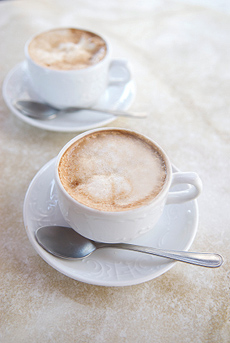 What espresso type is your favorite? Cappuccino is espresso with crema, a cap of foam. Photo by Pesky Monkey | IST.
What espresso type is your favorite? Cappuccino is espresso with crema, a cap of foam. Photo by Pesky Monkey | IST.
October 2006
Last Updated November 2025
|
 |
What’s Your Favorite Espresso Type?
Page 3: Espresso Glossary A To C
Discover The Different Types Of Espresso Drinks
& Other Espresso Terms
This is Page 3 of a four-part article. Click on the black links below to read the other parts. You can find general coffee terms in our Coffee Glossary.
Espresso Glossary
After you’ve had your fill of espresso, take a look at our other food glossaries—an easy way to get up to speed on more than fifty different food categories.
Click on a letter to go to the appropriate glossary section:
a b c d e f g h i j k l m n o p q r s t u v w x y z
This glossary is protected by copyright and cannot be reproduced in whole or in part. You are welcome to link to it.
|
AFFOGATO
Espresso served over ice cream, traditionally vanilla. When served over chocolate ice cream, it is sometimes called an affogato mocha. Affogato means “drowned” in Italian.
BARISTA
The Italian term for bartender, also used, for the person who operates the espresso brewing equipment (or makes other coffee drinks) at a café or coffeehouse.
BLACK EYE
A cup of American coffee with two shots of espresso. Also known as Slingblade. See also red eye.
|
|
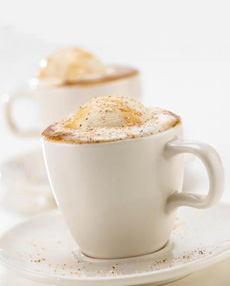
Affogato: a dessert that combines cappuccino and ice cream. Photo courtesy Talenti Gelato. |
|
CAFÈ
The French word for coffee and a coffee shop.
CAFÉ CRÈME
Popular in Switzerland and becoming more so in the U.S., café crème is brewed in a similar manner to normal espresso but at a faster pace and for a larger portion. Classic espresso brews about 1 to 1.5 ounces in 28 seconds, while café crème brews 5 ounces or more in 28 to 30 seconds. This is achieved by moving the grind fineness dial to the coarsest setting, to allow for more flow-through into the cup.
CAFÉ AU LAIT
A coffee drink made with brewed in a ratio of 1:1 milk to strong coffee, with sugar added to taste. As opposed to latte, which is made with milk and espresso, café au lait is typically made with a French roast or Italian roast bean.
|
|
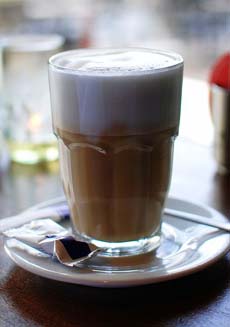
Café au lait, a French-style latte made with French roast coffee instead of espresso. Photo by Takeaway | Wikimedia. |
CAFÉ CON LECHE
Spanish for “coffee with milk,” the coffee is a dark roast (often espresso) that is topped with milk that is first scalded. It is similar to a latte in the 1:1 ratio of coffee to milk, but the milk is not foamed.
|
CAFFÈ
The Italian word for coffee. In Italy, as in much of Europe, ordering un caffè means an espresso. In France, the term café is used as well, but the French cup of coffee is slightly larger and the coffee is usually a dark roast instead of an espresso. Caffè americano is also available (see below).
CAFFÈ AMERICANO
A shot of espresso with 6 to 8 ounces of hot water added. The result approximates regular American coffee. Originally devised as an insult to Americans who wanted their espresso diluted.
|
|
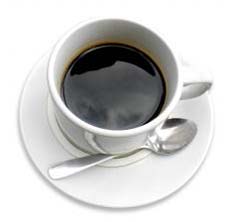
A good old cup of Joe is un caffè in Italian. Photo courtesy SXC.
|
CAFFÈ BREVE
Steamed half-and-half poured over espresso. Essentially, it’s a cappuccino made with half-and-half: very rich, and also very difficult to foam (the lower the fat content, the easier milk is to foam).
|
CAFFÈ CORRETTO
Caffè corretto is an alcoholic espresso, usually a shot of espresso with a small amount of grappa (brandy and sambuca are also used. It is ordered as “un caffè corretto alla grappa,” “... alla sambuca,” etc. Outside of Italy, it can be called espresso corretto. Most Italian bartenders simply add a few drops of the desired spirit into an espresso shot; however, in some cases, the spirit is served as a separate shot alongside the espresso, enabling the customer to pour the desired quantity. The term translates to “corrected” coffee. Why? According to some food historians, it creates a perfect union of grappa and coffee; thus, a “corrected” coffee. Others say that when tariffs on coffee went up in Fascist Italy, spirits were added to correct the taste of cheaper coffee substitutes. Here’s the history of caffè corretto.
|
|
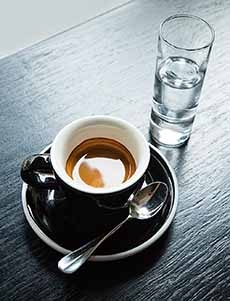
Caffè corretto is espresso with added spirits or with a shot on the side (photo © Punch Drink).
|
|
CAFFÈ LATTE
A shot of espresso with steamed milk in a 3:1 ratio of milk to espresso. In France and Italy, this is a breakfast drink. that is based on espresso (or moka coffee) combined with steamed milk. In America, it also serves as the basis for flavored lattes, where a sweet syrup is added in any variety of flavors, including mocha, hazelnut, and vanilla.
|
|
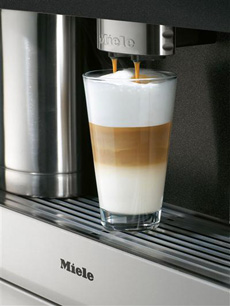
Latte is comfort food. Photo courtesy Miele. |
|
CAFFÈ MACCHIATO
An espresso is served in an espresso cup with a small dollop of steamed milk added to the top. Most Italians add a teaspoon of sugar. In Italy, this is a mid-morning drink. Macchiato means “marked” in Italian.
CAFFÈ MOCHA
Traditionally, steamed chocolate milk is poured over espresso, although more cafés use chocolate syrup because the sugar in chocolate milk tends to crystallize on the steaming wand, making cleanup a chore. Some establishments top the beverage with whipped cream.
CAFÉ TOBIO
Two shots of espresso with an equal amount of American coffee.
|
|
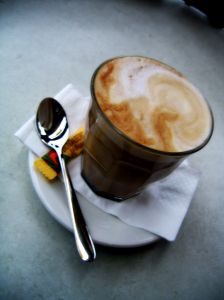
A macchiato—without the classic “dot” that marks it. Photo by Travis Walker | SXC. |
|
CAPPUCCINO
Two shots of espresso topped with steamed and foamed milk, in equal thirds. It is named for the cap of foam on the top, which somewhat resembles the hooded robe of the Roman Catholic Capuchin friars. It can be topped with ground cinnamon or other spices, or with ground chocolate or sweetened cocoa powder.
CHIARO
Italian for “light.” A milk drink may be prepared chiaro by adding more milk, or scuro (dark) by adding less. Pure steamed milk is a popular late-night drink in Italy, flavored with almond syrup or a dusting of chocolate.
|
|
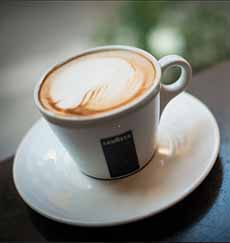
Cappuccino, beloved for its creamy foam (photo © Taralucci e Vino). |
CODA DI TOPO
Italian for “mouse tail.” The shape and pour of the streams of espresso as they leave the spouts of the espresso machine. Often used as a judging characteristic of a good pour.
COFFEE
All coffee drinks are made from the coffee bean. This glossary features drinks made with espresso, a particular dark roast of the coffee bean. Beans from any origin can be made in an espresso roast. We think of espresso roasts as dark brown to black beans, shining with oil from the bean. However, beans for espresso can be any variety of roasts and colors. The very lightest roasts for regular brewing (cinnamon or tan colored, for example) cannot be used for espresso; but otherwise any roast level will work. Espresso is typically a blend of different beans to achieve a heavy body and subdued acidity, with enough sweetness to balance the bitter and acidic flavors.
COFFEE BED or COFFEE PACK
The tamped volume of grinds in the filter basket. If your espresso is too weak, the coffee bed may be improperly tamped.
|
CORETTO
An espresso with some sort of liquor added. Corretto is Italian for “corrected.” See caffè corretto, above.
CORTADO
A cortado is an espresso cut with a small amount of warm milk. The word means “cut” in Spanish.
CREMA
A dense, foamy “cap” on the top of an espresso is created by the dispersion of air and carbon dioxide in the liquid at high pressure. The crema contains emulsified oils and forms a caramel or dark golden brown layer resembling foam on top of an espresso shot. Some machines are enhanced to produce crema.
|
|
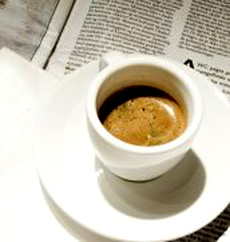
Even though the espresso is half-drunk, the foamy crema cap remains. Photo courtesy SXC.
|
CUBANO
Sugar is added to the espresso grounds during brewing for a sweet taste. The sugar can also be stirred into a small amount of espresso after brewing, and then mixed with the rest of the shot.
Continue To Part IV: Espresso Glossary Terms D To Z
Return To Article Index Above
Recipes © copyright their respective owners. Additional material Lifestyle Direct, Inc. All rights reserved.

|










